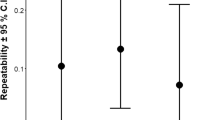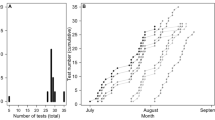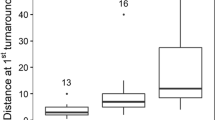Abstract
Consistent individual differences in boldness have been identified in many species and can have important effects on fitness. In most animals, juveniles face different costs and benefits of risk-taking behavior than do adults. Furthermore, profound changes in hormones, morphology and environment often occur when juveniles become adults. Therefore, the boldness of individuals might change with ontogeny. In field crickets, adult males call to attract sexually receptive females, and male calling increases predation risk. We measured the repeatability of boldness (latency to emerge from a safe refuge) in both male and female crickets. Each cricket was tested once as a small nymph and once as an adult. We found that boldness was repeatable across metamorphosis in females, but not in males. Males became less bold with maturation, a result that we predicted because of the risk associated with calling for mates. We also found that in general, nymphs were bolder than adults and that individuals spent more time immobile in response to a predator cue when they were nymphs, versus when they were adults.


Similar content being viewed by others
References
Ball EE, Oldfield BP, Rudolph KM (1990) Auditory organ structure, development, and function. In: Huber F, Moore TE, Loher W (eds) Cricket behavior and neurobiology. Cornell University Press, New York, pp 391–421
Bell AM, Stamps JA (2004) Development of behavioural differences between individuals and populations of sticklebacks, Gasterosteus aculeatus. Anim Behav 68:1339–1348
Bell AM, Hankison SJ, Laskowski KL (2009) The repeatability of behaviour: a meta-analysis. Anim Behav 77:771–783
Benjamini Y, Drai D, Elmer G, Kafkafi N, Golani I (2001) Controlling the false discovery rate in behavior genetics research. Behav Brain Res 12:279–284
Boissy A (1995) Fear and fearfulness in animals. Q Rev Biol 70:165–191
Briffa M, Rundle SD, Fryer A (2008) Comparing the strength of behavioural plasticity and consistency across situations: animal personalities in the hermit crab Pagurus bernhardus. Proc R Soc Lond B 275:1305–1311
Brodin T (2009) Behavioral syndrome over the boundaries of life- carryovers from larvae to adult damselfly. Behav Ecol 20:30–37
Brown C, Burgess F, Braithwaite VA (2007) Heritable and experiential effects on boldness in a tropical poeciliid. Behav Ecol Sociobiol 62:237–243
Carere C, Drent PJ, Privitera L, Koolhaas JM, Groothuis TGG (2005) Personalities in great tits, Parus major: stability and consistency. Anim Behav 70:795–805
Cooper WE (2009) Variation in escape behavior among individuals of the striped plateau lizard Sceloporus virgatus may reflect differences in boldness. J Herpetol 43:495–502
Dangles O, Casas J, Coolen I (2006a) Textbook cricket goes to the field: the ecological scene of the neuroethological play. J Exp Biol 209:393–398
Dangles O, Pierre D, Magal C, Vannier F, Casas J (2006b) Ontogeny of air-motion sensing in cricket. J Exp Biol 209:4363–4370
Dangles O, Pierre D, Christides JP, Casas J (2007) Escape performance decreases during ontogeny in wild crickets. J Exp Biol 219:3165–3170
Dingemanse NJ, Kazem AJN, Réale D, Wright J (2010) Behavioural reaction norms: animal personality meets individual plasticity. Trends Ecol Evol 25:81–89
Drent PJ, van Oers K, van Noordwijk AJ (2003) Realized heritability of personalities in the great tit (Parus major). Proc R Soc Lond B 270:45–51
Erhard HW, Mendl M, Christiansen SB (1999) Individual differences in tonic immobility may reflect behavioural strategies. Appl Anim Behav Sci 64:31–46
Garcia LV (2003) Controlling the false discovery rate in ecological research. Trends Ecol Evol 18:553–554
Gyuris E, Feró O, Tartally A, Barta Z (2011) Individual behaviour in firebugs (Pyrrhocoris apterus). Proc R Soc Lond B 278:628–633
Harris S, Ramnarine IW, Smith HG, Pettersson LB (2010) Picking personalities apart: estimating the influence of predation, sex and body size on boldness in the guppy Poecilia reticulata. Oikos 119:1711–1718
Hawlena D, Boochnik R, Abramsky Z, Bouskila A (2006) Blue tail and striped body: why do lizards change their infant costume when growing up? Behav Ecol 17:889–896
Hedrick AV (1986) Female preferences for male calling bout duration in a field cricket. Behav Ecol Sociobiol 19:73–77
Hedrick AV (1988) Female choice and the heritability of attractive male traits — an empirical study. Am Nat 132:267–276
Hedrick AV (2000) Crickets with extravagant mating songs compensate for predation risk with extra caution. Proc R Soc Lond B 267:671–675
Hedrick AV, Dill LM (1993) Mate choice by female crickets is influenced by predation risk. Anim Behav 46:193–196
Hedrick AV, Kortet R (2006) Hiding behaviour in two cricket populations that differ in predation pressure. Anim Behav 72:1111–1118
Johnson JC, Sih A (2007) Fear, food, sex and parental care: a syndrome of boldness in the fishing spider, Dolomedes triton. Anim Behav 74:1131–1138
Johnsson JI, Sernland E, Blixt M (2001) Sex-specific aggression and antipredator behaviour in young brown trout. Ethology 107:587–599
Kelley JL, Magurran AE, Macias-Garcia C (2005) The influence of rearing experience on the behaviour of an endangered Mexican fish, Skiffia multipunctata. Biol Conserv 122:223–230
Kortet R, Hedrick A (2004) Detection of the spider predator, Hololena nedra by naive juvenile field crickets (Gryllus integer) using indirect cues. Behaviour 141:1189–1196
Kortet R, Hedrick A (2007) A behavioural syndrome in the field cricket Gryllus integer: intrasexual aggression is correlated with activity in a novel environment. Biol J Linn Soc 91:475–482
Kortet R, Hedrick AV, Vainikka A (2010) Parasitism, predation and the evolution of animal personalities. Ecol Lett 13:1449–1458
Lessells CM, Boag PT (1987) Unrepeatable repeatabilities — a common mistake. Auk 104:116–121
Lind J, Cresswell W (2005) Determining the fitness consequences of antipredation behavior. Behav Ecol 16:945–956
Lopez P, Hawlena D, Polo V, Amo L, Martin J (2005) Sources of individual shy–bold variations in antipredator behaviour of male Iberian rock lizards. Anim Behav 69:1–9
Mcquaid CD (1994) Feeding behavior and selection of bivalve prey by Octopus vulgaris Cuvier. J Exp Mar Biol Ecol 177:187–202
Overli O, Sorensen C, Nilsson GE (2006) Behavioral indicators of stress-coping style in rainbow trout: Do males and females react differently to novelty? Physiol Behav 87:506–512
Piyapong C, Krause J, Chapman BB, Ramnarine IW, Louca V, Croft D (2010) Sex matters: a social context to boldness in guppies (Poecilia reticulata). Behav Ecol 21:3–8
Pratt AE, McLain DK, Berry AS (2005) Variation in the boldness of courting sand fiddler crabs (Uca pugilator). Ethology 111:63–76
Réale D, Reader SM, Sol D, McDougall PT, Dingemanse NJ (2007) Integrating animal temperament within ecology and evolution. Biol Rev 82:291–318
Réale D, Martin J, Coltman DW, Poissant J, Festa-Bianchet M (2009) Male personality, life-history strategies and reproductive success in a promiscuous mammal. J Evol Biol 22:1599–1607
Relyea RA, Hoverman JT (2003) The impact of larval predators and competitors on the morphology and fitness of juvenile treefrogs. Oecologia 134:596–604
Robards MD, Anthony JA, Rose GA, Piatt JF (1999) Changes in proximate composition and somatic energy content for Pacific sand lance (Ammodytes hexapterus) from Kachemak Bay, Alaska relative to maturity and season. J Exp Mar Biol Ecol 242:245–258
Schuett W, Dall SRX (2009) Sex differences, social context and personality in zebra finches, Taeniopygia guttata. Anim Behav 77:1041–1050
Sih A, Bell AM, Johnson JC, Ziemba RE (2004) Behavioral syndromes: an integrative overview. Q Rev Biol 79:241–277
Sinn DL, Gosling SD, Moltschaniwskyj NA (2008) Development of shy/bold behaviour in squid: context-specific phenotypes associated with developmental plasticity. Anim Behav 75:433–442
Smith BR, Blumstein DT (2008) Fitness consequences of personality: a meta-analysis. Behav Ecol 19:448–455
Stamps J, Groothuis TGG (2010) The development of animal personality: relevance, concepts and perspectives. Biol Rev 85:301–325
Urban MC (2007) The growth-predation risk trade-off under a growing gape-limited predation threat. Ecology 88:2587–2597
Vainikka A, Rantala MJ, Niemelä P, Hirvonen H, Kortet R (2011) Boldness as a consistent personality trait in the noble crayfish, Astacus astacus. Acta Ethol 14:17–25
Wilson AD, Whattam EM, Bennet R, Visanuvimol L, Lauzon C, Bertram SM (2010) Behavioral correlations across activity, mating, exploration, aggression, and antipredator contexts in the European house cricket, Acheta domesticus. Behav Ecol Sociobiol 64:703–715
Zera AJ, Zhao Z, Kaliseck K (2007) Hormones in the field: Evolutionary endocrinology of juvenile hormone and ecdysteroids in field populations of the wing-dimorphic cricket Gryllus firmus. Physiol Biochem Zool 80:592–606
Zuk M, Kolluru GR (1998) Exploitation of sexual signals by predators and parasitoids. Q Rev Biol 73:415–438
Acknowledgements
Special thanks to L. Berger, A. Leonard, C. Szeto, M. Tam, and C. Young-Yin for their assistance in the laboratory and to Niels Dingemanse for discussion. This work was funded by the National Science Foundation (IBN-0076484; AH), and by the Academy of Finland (decisions 204837 and 127398; RK).
Author information
Authors and Affiliations
Corresponding author
Additional information
Communicated by D. Gwynne
Rights and permissions
About this article
Cite this article
Hedrick, A.V., Kortet, R. Sex differences in the repeatability of boldness over metamorphosis. Behav Ecol Sociobiol 66, 407–412 (2012). https://doi.org/10.1007/s00265-011-1286-z
Received:
Revised:
Accepted:
Published:
Issue Date:
DOI: https://doi.org/10.1007/s00265-011-1286-z




